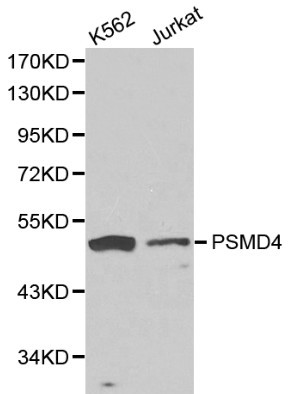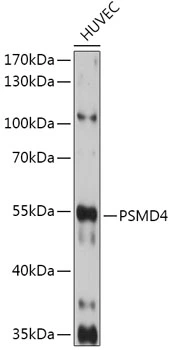PSMD4 antibody [N2C3]
GTX114679
ApplicationsImmunoFluorescence, Western Blot, ImmunoCytoChemistry
Product group Antibodies
TargetPSMD4
Overview
- SupplierGeneTex
- Product NamePSMD4 antibody [N2C3]
- Delivery Days Customer9
- Application Supplier NoteWB: 1:500-1:3000. ICC/IF: 1:100-1:1000. *Optimal dilutions/concentrations should be determined by the researcher.Not tested in other applications.
- ApplicationsImmunoFluorescence, Western Blot, ImmunoCytoChemistry
- CertificationResearch Use Only
- ClonalityPolyclonal
- Concentration0.93 mg/ml
- ConjugateUnconjugated
- Gene ID5710
- Target namePSMD4
- Target descriptionproteasome 26S subunit ubiquitin receptor, non-ATPase 4
- Target synonymsAF, AF-1, ASF, MCB1, Rpn10, S5A, pUB-R5, 26S proteasome non-ATPase regulatory subunit 4, 26S proteasome regulatory subunit S5A, S5a/antisecretory factor protein, angiocidin, antisecretory factor 1, multiubiquitin chain-binding protein, proteasome (prosome, macropain) 26S subunit, non-ATPase, 4, proteasome 26S subunit, non-ATPase 4
- HostRabbit
- IsotypeIgG
- Protein IDP55036
- Protein Name26S proteasome non-ATPase regulatory subunit 4
- Scientific DescriptionThe 26S proteasome is a multicatalytic proteinase complex with a highly ordered structure composed of 2 complexes, a 20S core and a 19S regulator. The 20S core is composed of 4 rings of 28 non-identical subunits; 2 rings are composed of 7 alpha subunits and 2 rings are composed of 7 beta subunits. The 19S regulator is composed of a base, which contains 6 ATPase subunits and 2 non-ATPase subunits, and a lid, which contains up to 10 non-ATPase subunits. Proteasomes are distributed throughout eukaryotic cells at a high concentration and cleave peptides in an ATP/ubiquitin-dependent process in a non-lysosomal pathway. An essential function of a modified proteasome, the immunoproteasome, is the processing of class I MHC peptides. This gene encodes one of the non-ATPase subunits of the 19S regulator lid. Pseudogenes have been identified on chromosomes 10 and 21. [provided by RefSeq]
- Storage Instruction-20°C or -80°C,2°C to 8°C
- UNSPSC12352203






